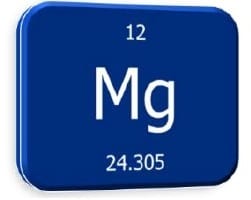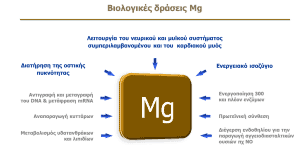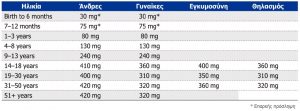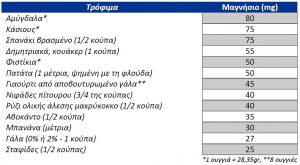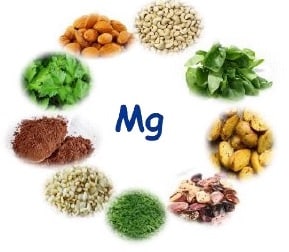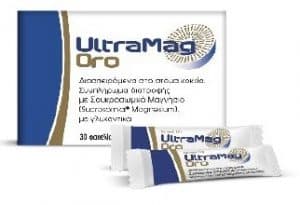Magnesium is an element that is abundant in nature.
It is the 9th most abundant element in the universe, the 8th in the earth’s crust and the 3rd in the sea.
It takes its name from Magnesia in Thessaly. The Romans called it Magnesia alba because of the white color of the carbonates found in the prefecture of Magnesia.
It was first isolated in 1808 by Sir Humphry Davy and in the 19th century it was used as an antacid, laxative and as an antidote to poisons.
It is the central atom in the chlorophyll molecule, a complex chemical compound that gives plants their green color and plays an important role in the process of photosynthesis and therefore in plant survival.
In recent decades there has been increasing evidence of the beneficial effects of magnesium on many functions of the human body. In the human body, it is the 4th most concentrated cation after sodium, potassium and calcium and the 2nd in the intracellular space after potassium. The human body contains 22-26 grams of magnesium which is mainly found in the bones and muscles and only 1% is found in the extracellular space.
The biological action of magnesium is due to its ability to make chelating compounds (very stable compounds formed between metallic elements such as magnesium, iron, etc. and organic compounds such as hemoglobin, chlorophyll, adenosine triphosphonate-ATP, etc.), but also to counteract the action of calcium.
Magnesium participates as a cofactor in more than 300 chemical reactions such as the binding of hormones (insulin, thyroxine, testosterone, etc.) to the receptor and the expression of their biological action, the signal transduction of neurotransmitters (dopamine, catecholamine’s, serotonin, GABA, etc.) and the expression of their biological action. etc.), synthesis of nucleic acids and proteins, carbohydrate and fat metabolism, muscle contraction, neuronal activity, vasomotor tone, calcium binding to its channels.
More generally, magnesium plays an essential role in the regulation of the body’s energy, the functioning of the nervous and muscular systems and bone health and is considered to be the natural calcium antagonist.
Magnesium is not produced by the body, but is taken in from food.
Daily magnesium requirements are related to gender, age and various physiological conditions such as pregnancy and breastfeeding. Women during this period of their lives have increased needs.
The recommended dietary intake of magnesium, according to the National Institute of Health as well as the Food & Nutrition Board is:
Magnesium is abundant in all foods except fats. Large amounts of magnesium are found in all green leafy vegetables since magnesium is a component of chlorophyll, as well as in whole grains, cereals, nuts and water. Smaller amounts are found in chocolate, fruit, meat and fish and dairy products.
Wholemeal products contain more magnesium than processed products because the processing of foods significantly affects their magnesium content, which can be reduced by up to 85%. Cooking, and in particular boiling foods, significantly reduces their magnesium content.
Foods rich in magnesium according to the National Institute of Health are :
Dietary magnesium is absorbed in the intestine, mainly in the intestine and ileum, and its absorption rate varies between 11-65%. Vitamin D and parathyroid hormone have a positive effect on absorption, while calcium, phosphorus and high-fat diets reduce absorption.
The kidney is a major regulator of magnesium in the body, having the ability to excrete up to 100% of the ion in cases of excess.
Factors that can affect magnesium levels in the body are:
- Inadequate dietary intake due to food processing and the western type of diet
- Increased needs such as in cases of physical or mental stress and pregnancy
- Increased elimination from the gastrointestinal tract (diarrhoeal syndromes etc.) and the kidney (macrocarbonic use of diuretics etc.)
- Progression of age
In the last century, a progressive decrease in the daily intake of magnesium has been observed, resulting in a lower intake than required and a more frequent deficiency than expected.
According to studies, magnesium deficiency is observed in 2.5-15% of the population. It is common in hospitalized patients (7-11%) and often coexists with deficiencies of other elements. Hypomagnesaemia has been observed in 40% of cases of hypocalcaemia, 30% of cases of hypophosphatemia and 23% of cases of hyponatraemia and hypocalcaemia.
The most common causes of magnesium deficiency are:
- The reduced intake
- Foods with less magnesium
- Poor diet (rich in meat and fat)
- Increased needs
- Pregnancy and breastfeeding
- Sport – intense physical activity
- Stress
- Reduced absorption
- Gastroenterological diseases
- Abuse of laxatives
- Use of drugs (chronic use of proton pump inhibitors, platinum, aminoglycosides, etc.)
- Age progression
- Alcoholism
- Increased excretion
- Diabetes
- Diuretics
Magnesium deficiency can be manifested by:
- Hypokalemia – hypocalcemia
- Muscle spasms and cramps
- Muscle weakness
- Headache and migraine
- Tachycardia
- Feeling of chronic fatigue (physical, mental and emotional)
- Reduced sports performance
- Mood disorders
- Bronchospasm
Magnesium deficiency can be treated with magnesium supplements in which magnesium is available as magnesium oxide, magnesium chloride, magnesium citrate, magnesium aspartate or magnesium pindoleate. Magnesium preparations are well tolerated but may cause gastrointestinal disturbances, particularly diarrhea. Their administration may interfere with the absorption of certain preparations such as bisphosphonates, calcium antagonists, etc.
Sucrosomal magnesium (UltraMag® Oro) is a new magnesium formulation that uses sucrosomal technology to transport and deliver magnesium to the body.
In this technology, magnesium is enclosed by a structure that passes through the gastrointestinal tract unaltered preventing the interaction of this ion with the gastrointestinal mucosa while ensuring high absorption in the small intestine.
The result is:
- avoidance of adverse effects from the gastrointestinal system
- high absorption
- administration on a full or empty stomach
- at any time of the day
- absence of metallic taste.
The absence of side effects combined with high efficacy and easy administration make the product user-friendly.
It is available in sachets containing granules which dissolve directly in the mouth and do not require water.
It has a pleasant taste.
Hypermagnesaemia is rare and may be observed when there is impairment of renal function with concomitant intake of laxatives or antacids containing magnesium or in pregnant women after intravenous administration.
Magnesium due to its biological role offers significant benefits:
Relieves
- From insomnia and headache
- From chronic fatigue
- From the symptoms of constipation
Helps
- Better functioning of the heart, nervous, muscular and respiratory systems
Contributes to
- Lowering blood pressure
- Maintaining bone density
- Protecting against diabetes
Reduces
- Stress and anxiety
- Muscle contractions and cramps
- The symptoms of pre-menstrual syndrome and dysmenorrhea
- The likelihood of complications in pregnancy
Sources:
- Coudray C et al, Magnesium Research, 2005;18(4):215-23
- Swaminathan R, Clin. Biochem. rev. 2003;24:47-66
- UltraMag® Oro product instruction sheet
- Grober U et al, Nutrients 2015;7:8199-8226
- Spyropoulou A. Kassis E. “Magnesium metabolism and its disorders”, Hellenic Osteoporosis Foundation, 2011
- Boyle NB et al, Magnesium Research, 2016;29(3):120-5
- Seelig MS, J. Am. Coll. Nutr. 1994;13(5):429-46
- Magnesium, Health Professional Fact Sheet https://ods.od.nih.gov/factsheets/Magnesium-HealthProfessional/)
- Zarean E. et al, Advanced Biomedical Research, 2017, IP: 79.129.0.33
- https://el.wikipedia.org/wiki/Μαγνήσιο
In Pharmacies
No. EOF: 107924/29-11-2017 (The notification number does not constitute a marketing authorization from the EOF).
Food supplements should not be used as a substitute for a balanced diet. This product is not intended for the prevention, treatment or cure of human disease. Consult a doctor if you are pregnant, breast-feeding, under medication or have health problems. Keep out of the reach of young children. Do not exceed the recommended daily dose.

